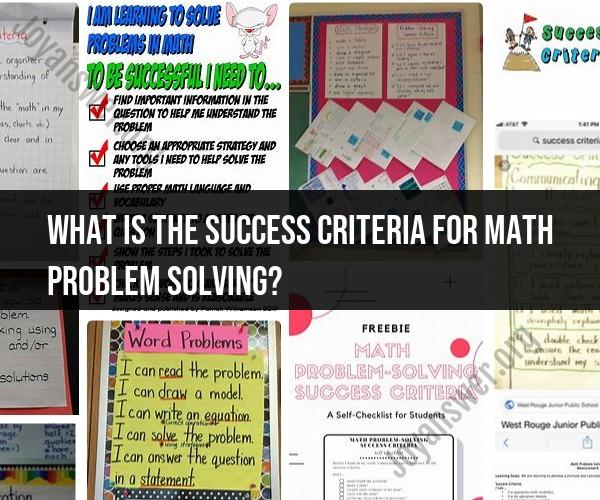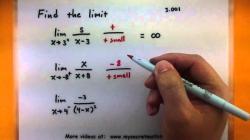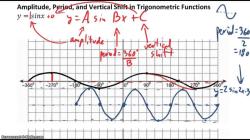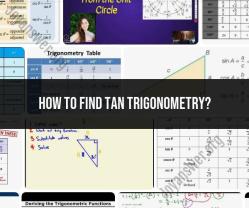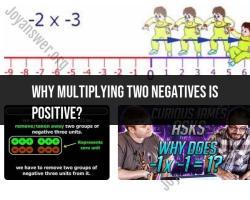What is the success criteria for math problem solving?
Success criteria for math problem solving can help students, educators, and problem solvers determine if they have effectively and correctly solved a mathematical problem. These criteria are guidelines that clarify what a successful solution should include. They may vary depending on the complexity and nature of the problem, but here are some general success criteria for math problem solving:
Understanding: The problem solver should demonstrate a clear understanding of the problem by correctly interpreting and restating the problem in their own words.
Correct Solution: The solution provided should be accurate and correct, addressing the main question or objective of the problem.
Appropriate Methods: The problem solver should use appropriate mathematical methods and techniques to arrive at the solution. This may involve the use of relevant formulas, theorems, or strategies.
Work Shown: The steps taken to arrive at the solution should be clearly shown and well-organized. This can include showing equations, calculations, and logical reasoning.
Units and Labels: If the problem involves measurements, the solution should include appropriate units (e.g., meters, seconds) and labels (e.g., "area," "velocity") to ensure clarity and completeness.
Relevance: The solution should address all aspects of the problem. It should not include extraneous information or calculations that are not relevant to the problem.
Justification: If the problem requires, the problem solver should provide appropriate justifications or explanations for their steps and conclusions. This may involve proofs, reasons, or logical arguments.
Check for Errors: The problem solver should review their work and the solution for errors, inconsistencies, and potential mistakes. Proofreading is important.
Alternative Methods: In some cases, it may be beneficial to explore and compare alternative methods to solve the problem, demonstrating a deeper understanding of the mathematical concepts.
Reasonable Estimations: If exact calculations are not possible or practical, the problem solver should use reasonable approximations and explain the rationale for doing so.
Conclusion: The solution should conclude with a clear and concise statement that directly answers the problem's question or objective.
Real-World Context: If the problem is situated in a real-world context, the solution should make sense within that context and should be communicated in a way that is meaningful to someone not familiar with the problem.
Neatness and Clarity: The presentation of the solution should be neat, legible, and well-organized. Diagrams and graphs, if used, should be clear and properly labeled.
Double-Checking: If time allows, it's advisable to double-check the solution to ensure its correctness.
Reflection: After solving the problem, the problem solver should reflect on the process and the solution, considering what they've learned and how they might approach similar problems in the future.
These success criteria can help guide problem solvers, whether they are students working on homework assignments or professionals tackling real-world mathematical challenges. By following these guidelines, individuals can develop effective problem-solving skills and ensure the accuracy and completeness of their mathematical solutions.
Defining Success in Math Problem Solving
Success in math problem solving can be defined in a number of ways. However, some common definitions include:
- The ability to accurately and efficiently solve math problems
- The ability to apply math concepts to real-world situations
- The ability to think critically and creatively about math problems
- The ability to persevere in the face of challenges
Strategies for Effective Math Problem Solving
There are a number of strategies that can be used to solve math problems effectively. Some of the most common strategies include:
- Identifying the problem: The first step in solving a math problem is to identify the problem that you are trying to solve. What is the unknown quantity? What information is given?
- Developing a plan: Once you have identified the problem, you need to develop a plan for solving it. This may involve brainstorming different approaches, or it may involve using a specific problem-solving strategy.
- Carrying out the plan: Once you have developed a plan, you need to carry it out. This may involve using math formulas, performing calculations, or drawing diagrams.
- Checking your work: Once you have solved the problem, you need to check your work to make sure that your answer is correct. This may involve going back over your calculations or using a different method to solve the problem.
Key Criteria for Assessing Success in Math Problem Solving
There are a number of key criteria that can be used to assess success in math problem solving. Some of the most common criteria include:
- Accuracy: The answer to the math problem must be correct.
- Efficiency: The problem should be solved in a timely manner.
- Explanation: The solver should be able to explain how they solved the problem.
- Generalization: The solver should be able to apply the problem-solving strategy to other problems.
Teaching Math Problem Solving Skills to Students
There are a number of things that teachers can do to teach math problem solving skills to students. Some of the most important things include:
- Providing students with opportunities to practice solving math problems. Students need to practice solving math problems in order to develop their problem-solving skills.
- Teaching students different problem-solving strategies. Teachers should teach students a variety of problem-solving strategies so that they have the tools they need to solve any problem they encounter.
- Encouraging students to think critically and creatively about math problems. Teachers should encourage students to think outside the box and come up with their own solutions to math problems.
- Providing students with feedback on their problem-solving skills. Teachers should provide students with feedback on their problem-solving skills so that they can identify their strengths and weaknesses and work on improving.
Real-Life Applications of Math Problem Solving Success
Math problem solving skills are used in a wide variety of real-world situations. For example, math problem solving skills are used to:
- Balance a budget
- Calculate the tip at a restaurant
- Estimate the time it will take to drive to a destination
- Determine the best deal on a product
- Solve puzzles and games
Math problem solving skills are essential for success in many different careers. For example, math problem solving skills are used by engineers, scientists, economists, and financial analysts.
In conclusion, math problem solving skills are important for both personal and professional success. There are a number of strategies that can be used to solve math problems effectively, and teachers can play an important role in teaching students these skills.
